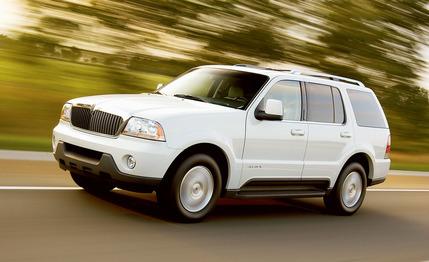
 Road Test
Road Test
Yes, Lincoln guessed wrong when it polished up a four-door, two-wheel-drive pickup, turned its bed into a kind of impractical upholstered trunk, called it the Blackwood, and asked 53 grand for it. They sold fewer than 3000 vehicles in all and pulled the plug last August.
We do not think, however, that Lincoln need fear a Blackwoodlike flop with its newest vehicle, the Aviator sport-utility vehicle. In fact, having spent a few weeks with it, we think it may be the best model in Lincoln's four-vehicle lineup.
The Aviator is like a trimmed-down version of Lincoln's bigger SUV, the Navigator, which is based on the full-size, 17-foot-long Ford Expedition. The Aviator is based on the Ford Explorer, the mid-size 16-footer that's the company's bestselling SUV. Lincoln sells about 30,000 of the big Navigators a year for about $49,000 to $60,000. Luxury SUVs are cash cows for the carmakers because they fetch high prices while running on platforms designed for less-expensive vehicles. So there's no mystery in the Aviator's intro. The problem is there's already a spruced-up Explorer in the Ford family, the Mercury Mountaineer. So the question becomes: How have Ford and Lincoln justified a second Explorer spinoff?
Lincoln, not surprisingly, says the Aviator is the top rung of the Explorer ladder. It does cost the most. The Aviator starts at $39,995 and can balloon to almost $49,000 with options. The Mountaineer, the first step down, runs between about $30,000 and $39,000, and the broad-appeal Explorer runs from roughly $26,500 to more than $40,000. To justify the extra money, Lincoln fitted the Aviator with a more-powerful engine, redesigned the suspension, and gave it a new body and interior. When Lincoln was done, the list of parts unique to the Aviator stretched far longer than the list of parts it shared with the Explorer.
Cross-town rival GM once cranked out such a steady stream of copycat cars badged as Chevys, Pontiacs, Oldsmobiles, Buicks, and even Cadillacs (remember the Cimarron?) that we now cringe every time we hear of another badge-engineered product. Then again, Audi convincingly transformed a lowly VW Golf into a chic TT, and we think Lincoln matched that success in making an Aviator out of an Explorer. And it's not simply because it stuffed in a big, honking V-8. It did, but we'll get to that later.
We forgot the Explorer roots as soon as we cracked open the door and peered inside. The Aviator's interior is nearly a carbon copy of the Navigator's handsome cocoon. Although we're not especially fond of Ford's recent epidemic of me-too styling - can you tell the difference between the old and new Explorers? - it's fine in this case. The interior is swathed in leather, plastic, brushed metal, and wood. It's by far the most stylish and functional of the Explorer triplets. On the outside, the Aviator faithfully mimics the Navigator's shell, sharing only doors and roof with the Explorer.
It was hot on the day we took delivery of our test Aviator, so we appreciated the optional seat fans blowing the sweat off our backs. Those cooled - and heated - seats are part of the $2950 Premium package that also includes an in-dash, six-disc CD changer and 17-inch wheels.
Our test vehicle also had the optional $2920 full-time four-wheel-drive system. It uses a viscous limited-slip center differential that automatically distributes the torque to the axle with more grip. During normal driving conditions the torque split is 35 percent to the front and 65 to the rear. On four-wheel-drive Aviators equipped with the combined traction-and-stability-control system, all torque goes to the rear wheels until they slip, at which point an electronically controlled clutch pack sends torque to the front wheels. A low-range transfer case is not available.